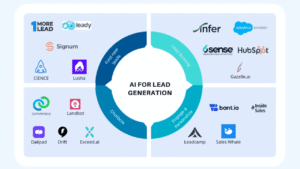Imagine your business as a bustling city—dynamic, interconnected, and full of opportunities. But just like a city needs vigilant security to guard against evolving threats, today’s organizations require robust defenses to protect their growing digital landscapes. As businesses embrace digital transformation to innovate and improve efficiency, they inadvertently open new doors for cyber threats. In 2023, cyberattacks surged by 38%, a stark reminder that the stakes now are higher than ever.
Traditional security measures today are no longer efficient enough to combat the sophisticated tactics of modern cybercriminals. This is where AI-powered cybersecurity steps in—a state-of-the-art solution that doesn’t just react but anticipates, adapts, and evolves to safeguard digital ecosystems. By leveraging artificial intelligence (AI) and machine learning (ML), organizations can detect threats as they arise, predict vulnerabilities, and respond in real-time to prevent breaches.
With the global AI in cybersecurity market projected to grow from $24 billion in 2023 to $134 billion by 2030, it’s clear that the future of cybersecurity lies in these transformative technologies. This blog dives into how AI and ML are reshaping cybersecurity, offering practical insights and real-world examples to help businesses stay secure in an increasingly complex digital world.
The Role of Digital Transformation in Cybersecurity
Digital transformation is the act of incorporating digital technologies in every aspect of an organization’s operations. Such a shift has made it possible for the firms to improve their customer experience and enhance overall efficiency. At the same time, it introduces new vulnerabilities into the system that can hardly be prevented with conventional antiviral and Firewall protections. The diverse nature of cloud computing, IoT devices, and big data analytics demands innovative solutions to help safeguard sensitive information and maintain smooth operations across an organization.
In 2023, the MOVEit Transfer, a widely used software for transferring files securely, was attacked by the Clop ransomware group. This breach impacted many organizations, including PBI Research Services due to leakage of millions of user’s information. This case demonstrates the risks being introduced as organizations undertake digital transformation initiatives, by leveraging third parties with little or no overall security assessments.
This instance showcases that when going digital, companies cannot avoid increasing their exposure to threats like ransomware, phishing, and APT. Thus, an integration of Artificial Intelligence and Machine Learning along with cybersecurity is vital for fighting any upcoming and evolving threats.
Key Technologies for AI Integration in Cybersecurity
The incorporation of AI into cybersecurity relies on several key technologies. These include:
- Natural Language Processing (NLP): NLP is used to analyze and comprehend textual data, which helps AI systems evaluate security logs, discover insider risks in communications, and identify phishing attempts.
- Machine Learning Algorithms: Over time, ML enables systems to enhance threat detection by learning from past data. Unsupervised learning finds new patterns, whereas supervised learning recognizes existing threats.
- Behavioral Analytics: An essential method for spotting insider threats and account compromises, AI uses behavioral patterns to discover abnormalities in user behavior.
- Cloud-Based Threat Intelligence: AI systems that use cloud platforms compile threat data from all around the world and offer real-time updates and predictive analysis.
Real-World Example
Palo Alto Networks uses ML-based firewalls that analyze data flows across cloud environments, detecting threats in real-time and automatically applying security patches.
AI-Powered Cybersecurity: Redefining Defense Mechanisms
AI-powered cybersecurity represents a shift from reactive to proactive defense strategies. Traditional methods rely on predefined rules and static databases, making them inadequate against complex attacks. AI and ML, on the other hand, ensure security systems have the ability to analyze vast amounts of data, identify patterns, and detect anomalies in real-time.
Benefits of AI-powered Cybersecurity
Key benefits include:
1. Enhanced Threat Detection: AI systems can process millions of entries and data points to identify suspicious activities that may hint towards a breach. By using AI for threat detection and ML algorithms, these systems learn to differentiate between normal and abnormal behaviors, ensuring accurate threat detection.
Real-World Example
In 2023, Microsoft deployed AI for threat detection to monitor its Azure cloud platform. This system identified a large-scale brute force attack targeting over 10,000 virtual machines. By analyzing login patterns and access behaviors, the AI flagged the anomalous activities, enabling Microsoft to mitigate the threat before any significant damage occurred. This proactive defense safeguarded millions of user accounts and reinforced the reliability of its cloud infrastructure
2. Automated Incident Response: Speed is critical in handling cyberattacks. AI-driven tools can automate responses to low-level threats, freeing up human resources to focus on more complex security challenges.
Real-World Example
In 2024, financial services giant JPMorgan Chase implemented an AI-powered Security Orchestration, Automation, and Response (SOAR) platform. When a phishing email campaign targeted the company’s employees, the AI system detected the malicious emails, quarantined them, and blocked further attempts within minutes. This automated response prevented potential breaches and allowed IT teams to focus on analyzing the root cause of the attack.
3. Predictive Analytics: By analyzing historical data and trends, AI enables organizations to identify potential threats and vulnerabilities. This predictive capability is invaluable in preemptively addressing risks.
Real-World Example
The U.S. Department of Defense (DoD) uses AI-based predictive analytics to enhance its cybersecurity framework. In 2023, the DoD’s system flagged unusual traffic patterns indicative of a future Distributed Denial of Service (DDoS) attack targeting critical infrastructure. By acting on these predictions, the department fortified its defenses, preventing an attack that could have disrupted national security operations.
4. Reduced False Positives: A common challenge in traditional cybersecurity systems is the high rate of false positives, which can be overwhelming for security teams. AI improves accuracy by refining its models based on continuous learning.
Real-World Example
In 2022, global telecommunications company AT&T implemented AI to improve its threat detection accuracy. Before the integration, the security team reported that 70% of alerts were false positives. Post-AI deployment, false positives dropped to just 10%, allowing the team to focus on genuine threats and significantly improving overall efficiency.
How to Implement AI and ML in Cybersecurity
Implementing AI and ML in cybersecurity is a multi-level process that requires careful planning and execution. Here’s a detailed step-by-step plan for it:
- Assess Current Needs and Define Goals
- Evaluate the organization’s current cybersecurity infrastructure and identify gaps in threat detection.
- Define clear objectives, such as reducing incident response times, improving threat detection accuracy, or automating repetitive security tasks.
- Conduct a Risk Assessment
- Perform a comprehensive risk analysis to understand the potential vulnerabilities within your organization.
- Use insights from this analysis to prioritize areas where AI and ML can make the most impact.
- Select the Right Tools and Vendors
- Research and compare AI-powered tools that align with your organization’s unique security needs.
- Choose trusted vendors with proven track records to ensure compatibility with existing systems and scalability for future growth.
- Data Preparation and Management
- Collect, clean, and preprocess data from internal and external sources.
- Implement strong governance policies to ensure data accuracy, security, and compliance with regulations like GDPR or CCPA.
- Use historical datasets to train ML models effectively and enhance their predictive capabilities.
- Pilot Implementation and Testing
- Begin with a small-scale implementation in a controlled environment, such as a specific department or application.
- Conduct rigorous testing to evaluate the tool’s effectiveness in detecting threats and automating responses.
- Integrate AI with Existing Systems
- Ensure seamless integration of AI tools with current cybersecurity platforms, such as SIEM (Security Information and Event Management) or SOAR (Security Orchestration, Automation, and Response) systems.
- Use APIs and middleware to enable smooth communication between tools.
- Train Security Teams and Stakeholders
- Provide comprehensive training to IT and security teams on how to use and interpret AI-driven insights.
- Create a culture of collaboration where security professionals work alongside AI systems to maximize effectiveness.
- Establish Continuous Monitoring and Feedback Loops
- Monitor AI tools regularly to evaluate their performance and train them to detect emerging threats.
- Collect feedback from security teams to refine models and improve outcomes.
- Implement self-learning mechanisms that allow AI systems to improve over time.
- Address Ethical and Compliance Considerations
- Ensure that the implementation of AI complies with relevant data protection laws and ethical guidelines.
- Conduct audits to confirm that AI models are free from biases that could lead to unfair or inaccurate threat assessments.
- Measure ROI and Adjust Strategies
- Continuously measure the return on investment (ROI) by assessing improvements in threat detection, reduced downtime, and cost savings from automation.
- Use these insights to refine strategies, expand AI adoption, and invest in advanced tools as needed.
Top 10 AI Tools Used in Cybersecurity in 2025
| Tool Name | Description | Key Features | Industry Usage |
|---|---|---|---|
| Darktrace | AI-based threat detection and response | Self-learning AI, real-time monitoring | Banking, Healthcare |
| Splunk Enterprise Security | Data analytics and incident management | Big data integration, advanced analytics | IT, Retail |
| CylancePROTECT | AI-powered endpoint security | Malware prevention, lightweight agent | Manufacturing, Government |
| FireEye Helix | Threat intelligence and analytics platform | Cloud-based, AI-driven detection | Financial Services, Energy |
| CrowdStrike Falcon | Endpoint protection and threat hunting | Behavioral analytics, cloud scalability | SaaS, Telecommunications |
| Palo Alto Networks Cortex XDR | Comprehensive threat detection and response | Unified data analysis, automation | Enterprise, Education |
| Symantec Endpoint Protection | Advanced malware detection and prevention | Machine learning-based threat analysis | SMBs, Enterprises |
| Fortinet FortiAI | AI for malware detection and prevention | Virtual analyst, automated threat scoring | IoT, Critical Infrastructure |
| Securonix | Security information and event management (SIEM) | Advanced user behavior analytics | E-commerce, Financial Services |
| Microsoft Defender | AI-driven endpoint protection | Cloud-native, integration with Azure | Education, Corporate Enterprises |
Use Cases of AI-Powered Cybersecurity in Action (h1)
The practical applications of AI-powered cybersecurity are vast spread across various sectors. By implementing AI’s capabilities, organizations can enhance their defense mechanisms and minimize risks effectively. Below are some examples of how AI is contributing in cybersecurity:
- Fraud Detection in Banking:
Financial institutions heavily rely on AI to detect and prevent fraudulent transactions in real-time. AI systems analyze transaction patterns, user behavior, and historical data to highlight any breaches.For instance, AI-driven platforms can identify examples of account takeover fraud by analyzing login patterns and geolocation data. In 2023, a global bank reported a significant reduction in fraud losses after implementing AI-powered fraud detection tools. These systems also help banks comply with regulatory requirements by generating accurate reports and audits. - Securing IoT Ecosystems:
The massive growth of IoT devices has introduced new vulnerabilities into networks. AI-driven systems now monitor IoT ecosystems to detect irregular device behavior, such as unexpected data transmissions or unauthorized access attempts.
For example, AI secures medical IoT devices, such as pacemakers and infusion pumps to ensure patient safety. - Endpoint Protection:
Endpoints like laptops, smartphones, and servers are prime targets for cyberattacks. AI-powered endpoint protection platforms analyze behavioral patterns to detect and resolve threats before they have a chance to cause any damage.
For instance, CrowdStrike’s AI-driven solution identified and stopped a ransomware attack on a corporate server within seconds, preventing data loss of thousands of users. - Phishing Prevention:
AI systems analyze email metadata, content, and user interactions to detect phishing attempts. These tools use NLP to identify any suspicious language patterns or malicious links.
In 2024, a large enterprise reduced successful phishing attacks by more than 50% after implementing an AI-powered email security solution. By preventing employees from engaging with malicious emails, the organization safeguarded their sensitive data and prevented any financial losses.
Overcoming Challenges and Ethical Concerns in AI-Powered Cybersecurity
While the benefits of AI in cybersecurity are endless, there are also several challenges and ethical considerations that any organization must take into account before implementing this technology into their systems:
- Bias in AI Algorithms:
If not carefully developed, AI models are likely to replicate the biases inherent in the data they use while training and therefore give wrong estimations of threats.For instance, some algorithms might unintentionally categorise some of the uncommon activities from certain parts of the world as threats. This can lead to unnecessary disruptions in the operations or bad reputation of the organization. The issue can be resolved by using diverse and representative datasets during the training phase of the machine learning models. In addition, it is vital to perform periodic checks of these AI systems for any loopholes and other forms of unwanted bias.
- Adversarial AI:
Today’s hackers are more sophisticated, and they employ AI methods to attack the networks’ security mechanisms. For instance, malicious individuals can input tainted data into an AI to misidentify threats or evade diverse forms of identification.In a notable 2023 case, hackers were able to bypass secure AI-based malware detection system by introducing obfuscated code to the system that allowed them to execute their attack. These tactics require organizations to have solid shields in the form of adversarial testing and ultramodern anomaly detection to prevent such attacks.
- Privacy Concerns:
The fact that most AI operations in the cybersecurity domain involve handling large amounts of data means that privacy concerns are paramount. Many AI systems need to gather a substantial amount of sensitive data, and if not processed properly, this can result in severe data leak.
Also, there are rules and regulations that must have to be followed at the time of data collection and processing such as GDPR & CCPA. Businesses must ensure to encrypt their data and anonymize the data to meet these standards and continue to collect the approval of their users while staying on the right side of the law.
How to Address These Challenges:
- Transparent Practices: Develop clear guidelines on how AI algorithms process data and communicate these policies to stakeholders.
- Robust Training Datasets: Use high-quality, diverse datasets to train AI systems and minimize the risk of bias or inaccuracies.
- Ethical AI Development: Establish a governance framework that ensures AI systems are aligned with ethical standards and regulatory requirements. This includes routine audits and independent reviews to verify system fairness and reliability.
By addressing these challenges proactively, organizations can harness the full potential of AI-powered cybersecurity while maintaining trust and compliance.
The Future of AI in Cybersecurity (h1)
The future of cybersecurity lies in the seamless integration of AI-powered solutions with traditional methods. As AI technologies continue to evolve, they will play an increasingly pivotal role in addressing emerging threats. Some anticipated developments include:
- AI-Driven Zero Trust Models: AI will enhance zero trust architectures by continuously verifying user identities and monitoring network access.
- Advanced Behavioral Analysis: Future AI systems will delve deeper into user behavior to detect nuanced anomalies and potential insider threats.
- Collaborative Defense Ecosystems: Organizations will adopt AI platforms that facilitate collaboration and knowledge sharing across industries.
- Integration with Quantum Computing: The combination of AI and quantum computing holds the potential to revolutionize encryption and threat detection.
Conclusion: Building a Secure Future with AI-Powered Cybersecurity
The intersection of digital transformation and cybersecurity represents both an immense opportunity and a significant challenge for businesses today. AI and ML are no longer aspirational technologies—they are indispensable tools that redefine how organizations approach their security strategies. By integrating these advanced technologies, businesses can move beyond traditional reactive defenses and adopt a proactive stance, identifying threats before they escalate and automating responses to ensure uninterrupted operations.
However, embracing AI-powered cybersecurity requires more than just adopting new tools. It calls for a thoughtful strategy that aligns with an organization’s unique needs and challenges. Companies must focus on bridging gaps in their current systems, training their teams to effectively work alongside AI solutions, and fostering a culture of continuous improvement to adapt to the ever-evolving threat landscape.
At Tech-Transformation, we understand the complexities of navigating these changes. Our mission is to empower businesses to not only protect their digital assets but also leverage cutting-edge AI tools to enhance their operations and drive sustainable growth. Whether you’re just starting your journey or looking to optimize your existing frameworks, we are here to guide you every step of the way. Together, we can build a future where innovation and security go hand in hand, ensuring your organization thrives in the digital age.








